#Terry Amthor
Photo



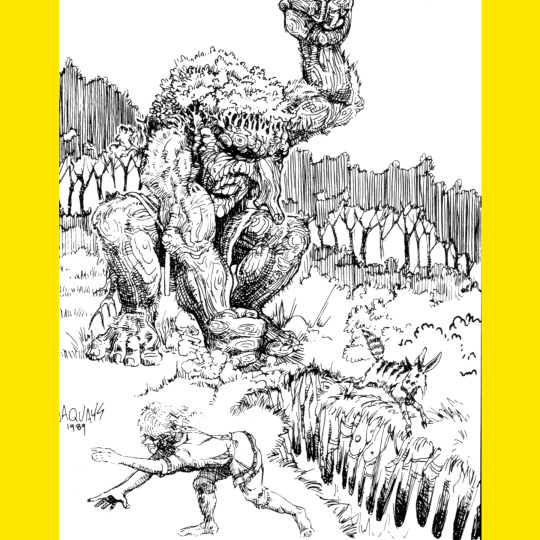



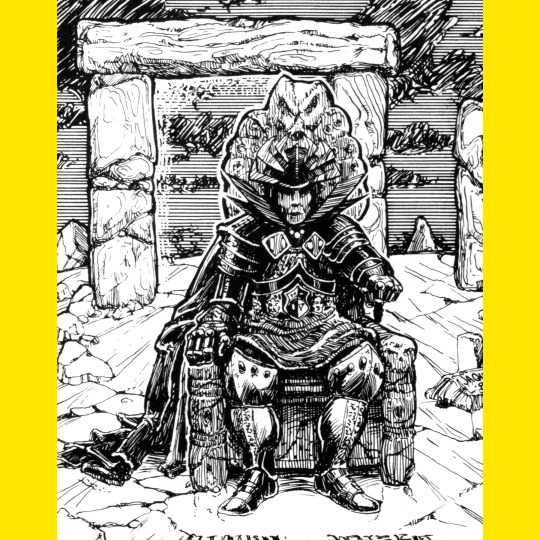
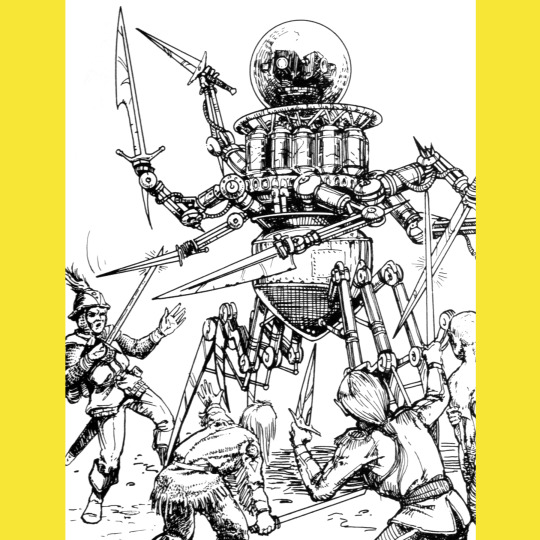

Demons of the Burning Night (1989) came out the same year as the Shadow World Atlas and re-establishes what to expect from a Shadow World module (structurally, they are very similar to the older Loremaster modules and, honestly, many of the MERP books, which should be unsurprising since Shadow World creator Terry K. Amthor had a hand in all of that as one of Iron Crown’s founders).
The focus of this book is the island of Aranmor, which is kind of like the Isle of Dread from D&D but with a black metal soundtrack. Everything living there is evil. Like, really, really evil. To the point that most adventurers avoid the place, despite the fact that it is a treasure trove of first age technology and magical artifacts. You kind of get that sense from the Tony Robert’s excellent cover.
Even the good stuff is kind of terrible. There is a horn that when blown, basically annihilates whatever is in front of you. But if you blow it twice before the moon Varin turns fully (ten days) the thing explodes, basically nuking everything in a 50’ radius. It’s beautiful, really.
The majority of the book is given over to detailing the ruined city of Tarek Nev, a horrible place full of danger. Even the trash pit is deadly (it's a demon, concealed by sand, that just exists to digest garbage and whatever adventurers happen to step into its mouth). A fantastic resource, if you’re in need of a demon haunted city.
#RPG#TTRPG#Tabletop RPG#Roleplaying Game#D&D#dungeons & dragons#Shadow World#Terry Amthor#Jennell Jaquays#Iron Crown#Rolemaster#Demons of the Burning Night
83 notes
·
View notes
Text
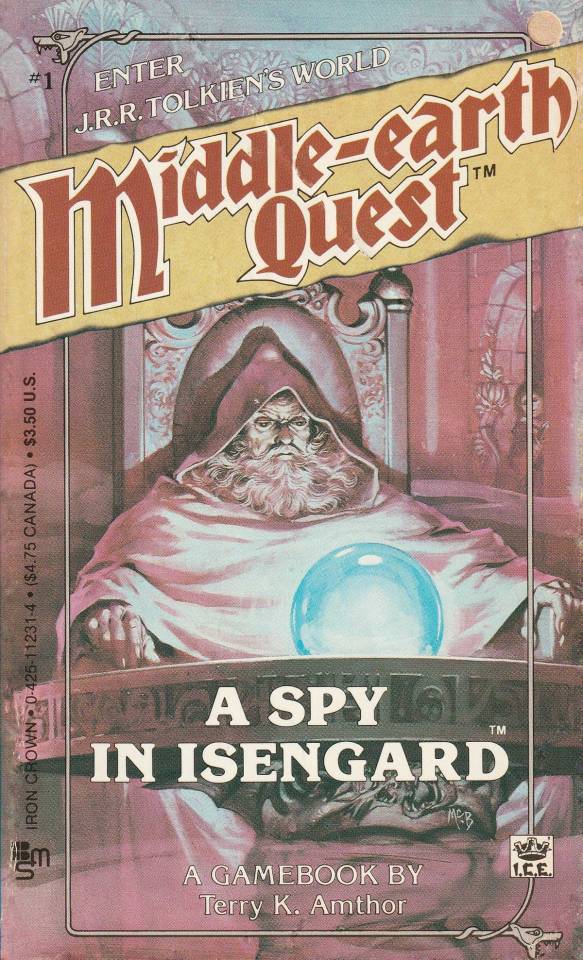
Saruman the White ponders his palantír. "You are the trusted apprentice to one of the greatest Wizards in all Middle-earth" in A Spy in Isengard (Angus McBride cover art for Middle-earth Quest gamebook #1 by Terry K Amthor, Iron Crown Enterprises, 1988). McBride has been memed more than once.
#pondering my orb#wizard#Angus McBride#orb#Saruman#LotR#A Spy in Isengard#Middle-earth#palantir#Saruman the White#Middle-earth Quest#middle earth quest#JRR Tolkien#Tolkien#Terry K Amthor#game book#istar#istari#lord of the Rings#The Lord of the Rings#middle earth#palantír#mage#magic user#crystal ball
1K notes
·
View notes
Photo
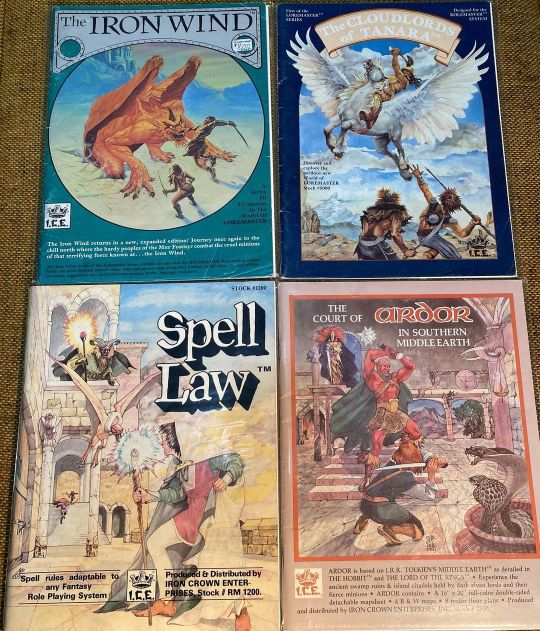
Although it has received little notice, the author Terry K. Amthor has died. He was a cofounder of Iron Crown Enterprises (ICE), one of the most creative RPG studios in the history of RPGs, he was involved in the creation of Rolemaster, wrote many Middle Earth Roleplaying modules, co-created Spacemaster, and created the fascinating Shadow World, among other feats. He was one of the most influential figures in my life with RPGs. He also came out in a historical article entitled "Queer as a Three-sided Die." "TKA: And in a somewhat unrelated topic, I got a little fame for my article ‘Queer as a Three-sided Die’ in White Wolf Magazine back in 1994, about feeling isolated as the only gay gamer (besides one other guy in the industry) that I knew of. The WW guys said it got a tremendous response. The last few years at GenCon now they hold a seminar with that name. BH: As you mentioned, your 1994 article in White Wolf “Queer as a Three-sided Die” helped motivate a recurring seminar at Gen-Con of the same name. You’ve included both gays and women in Shadow World: the Sarnak amazons and the Komaren Cluster “Sherikaan” (SW term for gays). There seems to be an emphasis on “minorities”, can you elaborate on that and its importance to you in your creative process TKA: I dunno, it just seemed natural to me. I knew I was taking a risk of offending people including an entire gay culture in SW, but that was when I was writing SW unsupervised for the first time and thought, what the hell. (The main protagonist in my SW novel is also gay). I never got any negative feedback, and even got a few letters and emails praising it. As far as women and other races, it just seemed natural to me, especially after Middle-earth, which is totally dominated by men, (except for Galadriel), and the only people of color were savages from Harad who served Sauron. Back in the 80’s the gaming world was overwhelmingly white and str8. Fortunately it has changed quite a bit, along with popular culture." Interview from the Rolemaster Blog. #terrykamthor #rolemaster #merp #middleearthroleplaying #ironcrownenterprises #spacemaster #shadowworld https://www.instagram.com/p/CUqyKYplFJI/?utm_medium=tumblr
0 notes
Text
Raising Azazel (a FUDGE game)
So you may remember that I wrote at the start of November that I was going to do the NaGaDeMon challenge this year.
I managed to write and publish my game, going by the name of Raising Azazel. It is a PWYW on Drivethrurpg.
The challenge I signed up for was a FUDGE specific one. There are lots of different challenges in the NaGaDeMon community and the FUDGE one suited me and was technically a bit easier in that the core mechanics are already tried and tested. It then became more about creating the setting and the story background and then customising FUDGE to bring it all together.
A month is surprisingly short when you set a deadline at the end of it!
The game I released was virtually unedited, had only been played once and in hindsight has some rather important omissions such as there is space of the character sheet for experience but absolutely no rules for experience in the game.
I did create lots of bespoke art for the finished, and I use the word finished lightly, game but every single piece is in exactly the same size and format. If I were to do the page layout again I would recreate most of the art.
I wanted the rule book to be almost a graphic novel with all the background and game setting depicted that way. As it is you get one page of the graphic novel and then a few odd panels dotted through the book. Graphic novels are hard to write if you are rather talentless as a writer!
Still talking about layout there is one example explaining a rule that is separated off into a boxout but none of the others are. I think they all should be so they are easier to find.
Something that I had seen in Terry Amthor’s Shadow World books that people seem to love are his vignette scenes at the top of each chapter. I had wanted to recreate that but the problem is that these require artistic talent as a writer. I did come up with something rather cool. I grabbed a couple of public domain books, one on devil worship in the 19th century and one on astrology. I then changed the odd word here, inserted my characters names for historical figures and such like and used these as extracts from fictitious books. I think they were quite cool but I think I need one at the top of every chapter so that the layout is consistent.
On the topic of chapters. I thought that it would be cool to have the chapter names and headings in Latin as there is a church conspiracy running through the game. This was a bad idea! Did you know that Chapter Six in Latin is Caput Sex? That is neither scary or cool.
So I have a choice now. I can confine Raising Azazel to the depths of OBS, never to be mentioned again or I can revise, edit, fix and improve the game. As I enjoyed the work I have done on it so far I rather fancy the second option.
So I am planning to try out Indiegogo. In the new year, I am stacked out right now with projects, I am going to launch a campaign and try and get some funding to do the bits I cannot do well done properly. It will also teach me something about how Indiegogo works and how to run a campaign.
If you are still reading this and you haven’t already seen the link to Raising Azazel on the Stargazer’s World MeWe group then could I ask you to have a look and give me some critical feedback in the comments? I can then evaluate it and build a todo list that will become part of the Indygogo campaign.
Here is that link again http://bit.ly/RaisingAzazelSGW
Related posts:
Raising Azazel Fudge Character Creation
Why Fudge needs a new edition
My gift to the Fudge community
Raising Azazel (a FUDGE game) published first on https://supergalaxyrom.tumblr.com
0 notes
Photo

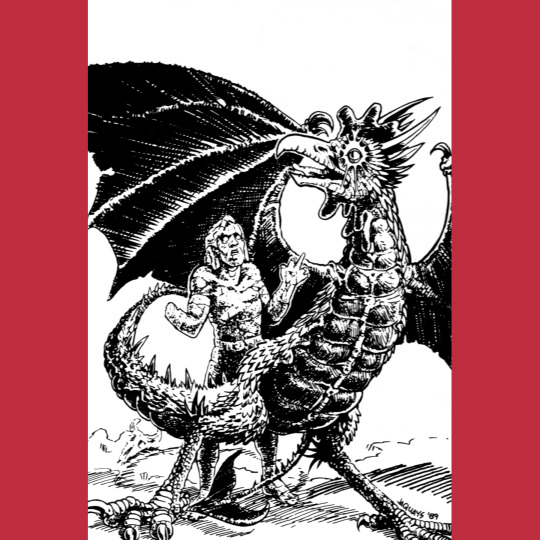
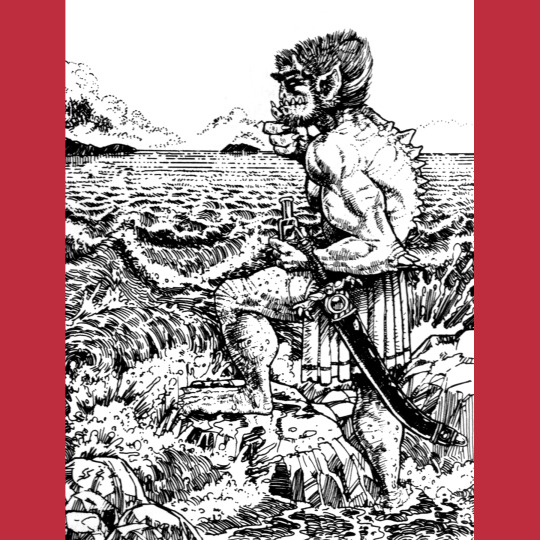
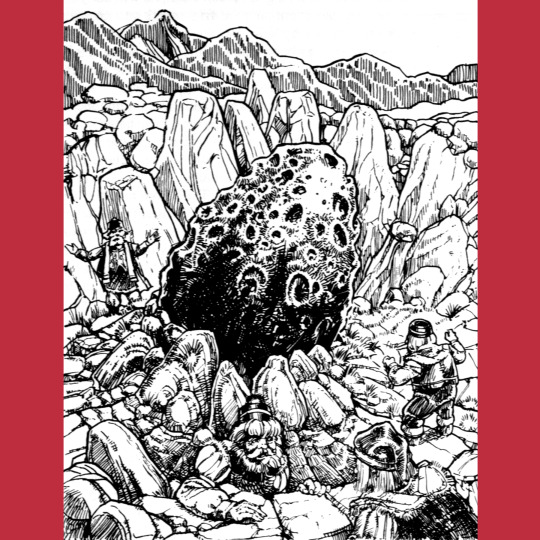


This is Tales of the Loremasters Book II (1989) and man, I gotta start by saying: how on earth did they get all this stuff (and more beside) all out in one year? This is a sequel?! How?!? There is a metric ton of 1989 Shadow World stuff and it boggles my mind. Did Iron Crown employees just not sleep?
Like the previous volume, this is a collection of adventure sites, all illustrated by Jennell Jaquays (I really like how she approaches landscapes in her Shadow World material). This one feels more varied in its locales. No nucklelavee, so you can’t have everything, but this one is a handy one to have around — you can drop this stuff into any campaign and make it work without a lot of conversion work. The one with the mysterious meteor is my favorite. The details are fine, but honestly, I mostly appreciate the prompt of “mysterious meteor” — there should be more of those in RPGs, generally, I think.
Wanted to post about this primarily for the cover art by David Martin. Granted, I would call this a cockatrice, not a basilisk (those, for me, are snakes who wear adorable crowns) but I love the idea of whatever it is turning everything to stone, gorgon-like (basilisks traditionally kill via venom and pollution, while cockatrices usually cause people to just drop dead by looking at them). I’ve talked before about the quality of smoothness in David Martin’s work. I often find it off-putting, but here it works so good. Maybe that is the influence of Ellisa Martin, who is also credited on the painting (though not inside in the actual credits)
#RPG#TTRPG#Tabletop RPG#Roleplaying Game#D&D#dungeons & dragons#Shadow World#Terry Amthor#Jennell Jaquays#Iron Crown#Rolemaster#David Martin#Tales of the Loremasters
69 notes
·
View notes
Photo



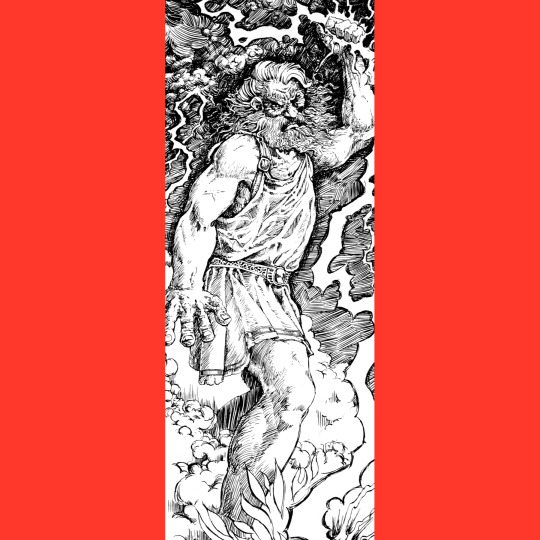



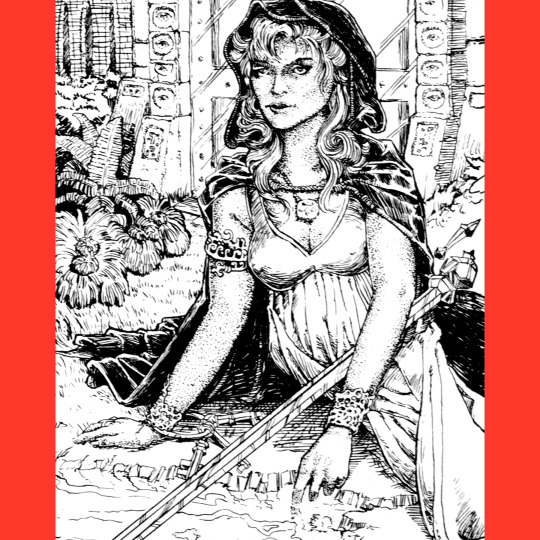

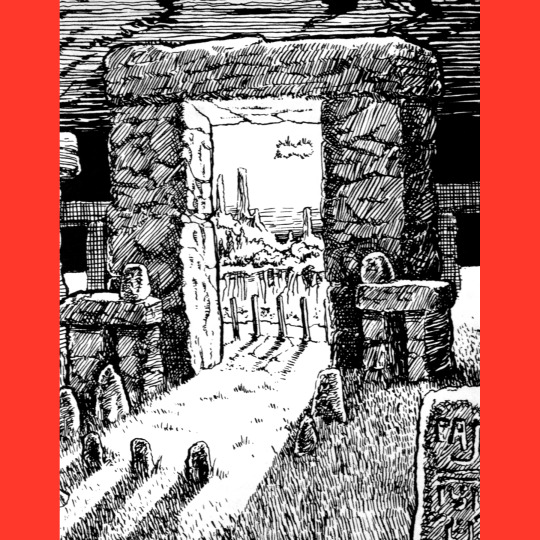
Shadow World! This is overdue and kind of thematically appropriate because Terry K. Amthor’s Shadow World seems to me to be unfairly overshadowed by other fantasy campaign settings. It is, however, wonderfully detailed and wildly weird, so perhaps after this week of posts you’ll be inspired to check it out.
The world was technically first introduced in 1980 in The Iron Wind for Iron Crown’s Rolemaster system, with further entries in the Loremaster series of modules, Vog Mur and Cloud Lords of Tanara (1984) adding additional locales, but it wasn’t clear until the Shadow World Atlas box set (1989) that all these places were part of the same world. In the box you have an overview of the world in one book, a look at the various (very Tolkien-esque) races in another, a final book detailing monsters and conversion notes and, of course, a big old map. Tony Roberts’ cover painting gives an immediate sense of the world, while Jennell Jaquay’s interior illustrations relentlessly underscore its weirdness.
From this material you get a sense of the world. Many aspects of it align with Middle-Earth, but made strange by civilizations running through rapid cycles of golden ages and collapse. The first societies of the world had access to fantastic technologies, many of which continue to malfunction into the present, causing weird weather patterns and other dangers — the very land, peppered with archipelagos, seems broken and a strange energy barrier cuts off access to half the planet. Magic is strong, to the point that it inhibits the development of other technologies (though the societies of Kulthea strike quite a range, from bronze age tribes to steampunk style groups with flying ships), a fact that the college of Loremasters seeks to counter by spreading knowledge. There are five moons and the gods live on them. Unlife is a constant and unambiguous threat, but there are many subtle evils in the world too. There’s a lot going on!
#RPG#TTRPG#Tabletop RPG#Roleplaying Game#D&D#dungeons & dragons#Shadow World#Terry Amthor#Jennell Jaquays#Iron Crown#Rolemaster
78 notes
·
View notes
Photo
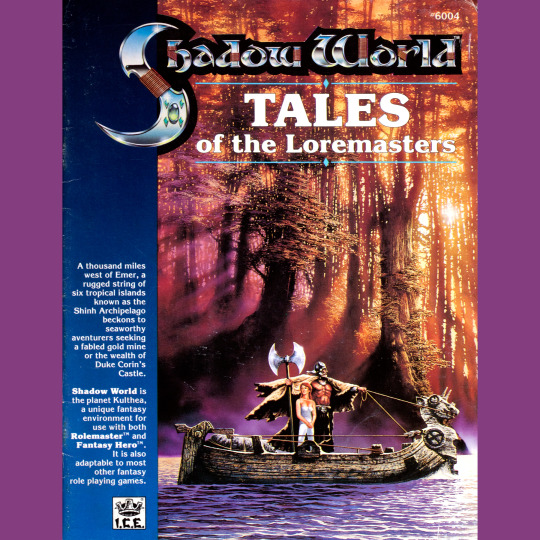
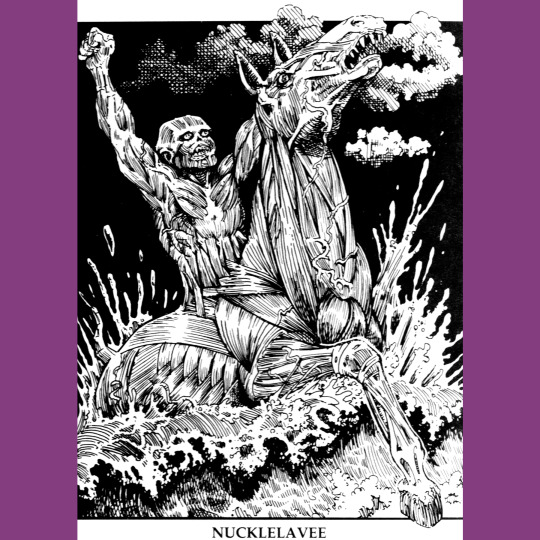
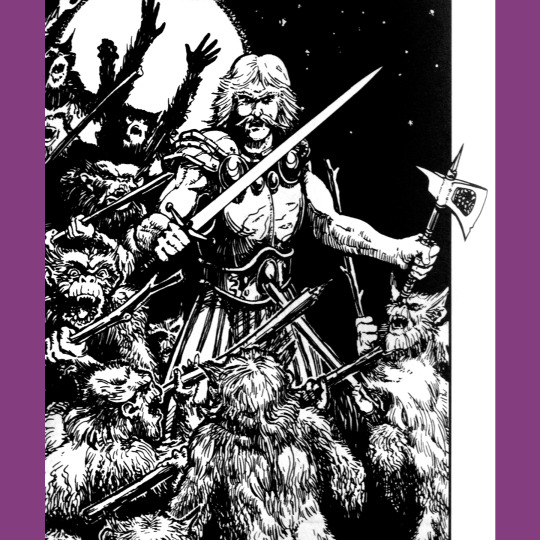


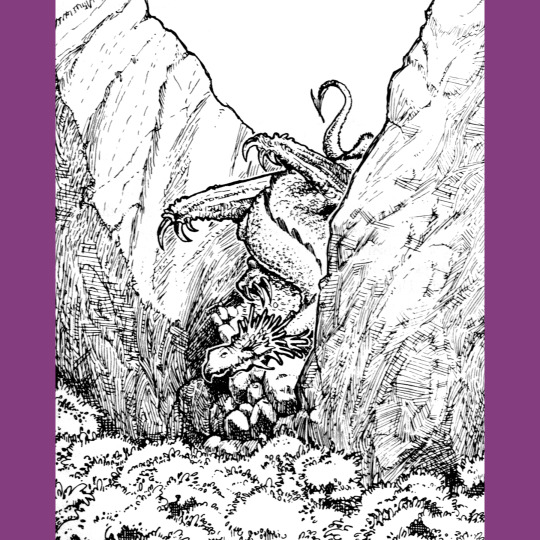
Tales of the Loremasters (1989) is an adventure anthology for Shadow World. It’s got a breezy pace, covering four large areas and then dozens of small adventure sites in short order. Tony Roberts has a nice Viking-themed painting on the cover that doesn’t quite jibe with my vision of Shadow World. Jennell Jaquays is again on the interior illustrations, which includes a nucklelavee. I was actually going to skip this one, because I don’t have much to say about it, but the nucklelavee tipped the scale. Love that monster.
To fill space, I feel like I should point out the fact that the Shadow World logo is constructed entirely of blades, and I find that terribly amusing for some reason.
#RPG#TTRPG#Tabletop RPG#Roleplaying Game#D&D#dungeons & dragons#Shadow World#Terry Amthor#Jennell Jaquays#Iron Crown#Rolemaster#Tony Roberts#Tales of the Loremasters
56 notes
·
View notes
Photo








The Orgillion Horror (1989) is another Shadow World module — this is the one I wanted back in the day, for reasons that are murky to me now. Perhaps the cover was used in advertising? Whatever the reason I had seen it, I definitely wanted to know more based on David Martin’s cover. That mansion just looks so strange! And fancy that: this is basically the “I’m a fan of Lovecraft and want to show it” Shadow World adventure. It’s a delightful mix of genuine horrors and winking references.
Unlike a lot of Shadow World material, this book is just adventure without the usual accompaniment of setting information. The adventure is in three parts. The first is an investigation of the estate on the cover, which the players can move into and renovate, thanks to convenient inheritance. It is, of course, full of gothic horrors, ghosts, lost treasure and other tasty treats. When all is said and done, it turns out that the player’s late uncle has a task for them, which requires digging him up, the subject of the second part. The crypt also contains a crystal skull, which I have to assume is a reference to underloved horror classic House II. Once you get Uncle Tytus’ corpse, you bring it back to the house resurrect so he can lead on to the final part: an expedition to a desert ruin inhabited by curious star-shaped aliens and some brain-eating entities. Good stuff made even better by Jennell Jaquays art throughout.
#RPG#TTRPG#Tabletop RPG#Roleplaying Game#D&D#dungeons & dragons#Shadow World#Terry Amthor#Jennell Jaquays#Iron Crown#Rolemaster#Orgillion Horror
61 notes
·
View notes
Text



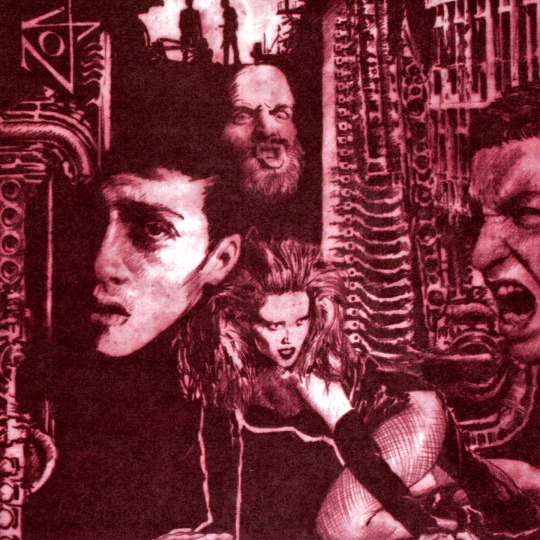

This week, let’s have a look at some horror games of the 1990s, awash with secret histories, conspiracies and pre-millennial tensions. First up, Kult! This is the first English edition (imported by Terry K. Amthor, of Shadow World fame) from 1993, but the original Swedish game is from 1991.
So, reality is actually a metaphysical prison constructed by the Demiurge in order to suppress humanity’s inherent divinity (see: Gnosticism, Phil Dick). However, the big D (the Demiurge, not Phil) has vanished and his illusion is starting to slip, giving humanity the chance for…something. Fulfilling that potential isn’t a walk in the park and even if players somehow attain it, the world beyond the illusion is pretty horrible — the haunted Metropolis, the burning Inferno, the swirling Vortex.
Like many ‘90s RPGs of this sort, players take the role of characters on the fringes of society who congregate in a sort of occult underground. The main mechanic here is mental balance. Those with zero are centered, normal, bought in to the Demiurge’s lie. Extremes in either direction open up the path to divinity. On the positive side are things like caring for people or throwing oneself into creativity. On the negative side are things like being exposed to supernatural horrors, indulging in drugs, witnessing violence and so on. It is far easier to tailspin into the negatives, which are often exacerbated by each character’s Secret (suffering from a mystical curse, for instance). It is likely that characters like this will burn up in the course of their investigations long before they have to worry about divinity. Which is sort of the point and half the fun (the long arc of mental balance is more like a freeform guideline rather than a usable mechanic anyway).
Kult was originally part of the greater web of Basic Role-Playing derived games (coming to the system via Drakar Och Demoner, but now it is Powered by the Apocalypse). It’s unapologetic approach to morality, religion, sex and substance abuse sparked a bit of a moral panic over the game in Sweden, while in the States it got a mature readers warning. The benefits of having weathered the Satanic Panic, I guess.
130 notes
·
View notes
Photo







I swear, this was meant to be the week I finally cracked into Shadow World and I just wound up gravitating toward the old Loremaster books. However, there are only four of them, so you get a little bit of Shadow Wolrd after all! This is Cyclops Vale (1989) and it is very strange.
Shadow World was born (or, I guess, rebranded) out of the Loremaster books. Different line names, same world, though it wasn’t called Kulthea until the Shadow World branded products came out. Shadow World got a ton of support, with two macro level box sets each detailing a continent, several city source books and many regional splatbooks and adventures. All this was helmed by Iron Crown co-founder Terry Amthor. The world is rich and odd, a high fantasy world with a science fiction substrate.
Cyclops Vale is a good example of the line in general (though I promise I will dig into it in detail at some point). That weird ass cover by Tony Roberts sets the mood. Interior art by Jennell Jaquays maintains it – that obelisk in particular is striking. That the obelisk is the end of the Ascent of Doom and contains the Eternal Triangle gives some further sense of the surreal, almost cosmic quality a lot of Shadow World takes on.
There’s a brief overview of the region, but most of the book is devoted to adventuring sites, like the obelisk, the titular vale, a strange city, some mines, the usual sort of stuff. It is short, sweet, has lots of hours of play packed into it and gives just enough detail for you to weave a tale without forcing your players on a railroad. Its good stuff and part of an under-appreciated line.
#RPG#TTRPG#Tabletop RPG#Roleplaying Game#D&D#dungeons & dragons#Iron Crown Enterprises#Rolemaster#Shadow World#Cyclops Vale#Jennell Jaquays#Terry Amthor#Tony Roberts
27 notes
·
View notes
Photo

Valmorgûl, Warden of the Citadel of Ardor, as depicted on “The Magician” card in the arcane Ardan Deck (Charles Peale, The Court of Ardor in Southern Middle-earth by Terry K Amthor, ICE, 1983)
#Rolemaster#MERP#Charles Peale#Middle-Earth Role Playing#Middle-Earth#LotR#Valmorgul#Valmorgûl#elf#dark elf#Tolkien#Ardor#The Court of Ardor#The Court of Ardor in Southern Middle-Earth#Terry K Amthor#tarot#ardan deck#ICE#Iron Crown Enterprises#the magician#magician#mage#sorcerer
117 notes
·
View notes
Photo

This week on the Vintage RPG Podcast, we have such sights to show you. Wait, no, wrong horror franchise. But pretty close — we’re talking about Kult, the mature existential urban horror RPG imported from Sweden by Terry Amthor and Metropolis Ltd. The designers clearly had Clive Barker on their minds. We honestly barely scratch the surface, though, talking more about the edginess of the 90s, the trend of investigating secret histories in RPGs and all that pre-millennial tension that was in the air. We’ll be taking another, closer look at Kult down the line for sure.
#RPG#TTRPG#Tabletop RPG#Roleplaying Game#D&D#dungeons & dragons#Podcast#Kult#Metropolis#Horror#Clive Barker
31 notes
·
View notes